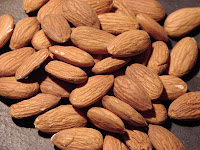One ounce of raw almonds (about 23 nuts) contains:

6 grams protein
14 grams fat
6 grams carbohydrate
3.5 grams fiber
For a total of 163 calories per ounce .
(From the USDA Nutrient Database)
Calorie content of foods is determined by summing up the calories from each constituent: 1 gram of fat = 9 calories; 1 gram protein = 4 calories; 1 gram carbohydrate = 4 calories. Calorie content can also be directly measured using a device called a burn calorimeter, in which the amount of energy released from a specific food is measured by literally burning it and gauging precisely how much energy is released. 
The problem with both of these methods is that it is assumed that all foods are digested with equal efficiency. That is, it assumes that a potato chip is as readily digested and absorbed as energy from table sugar, a pretzel, oatmeal, a piece of steak, or a handful of nuts. In real life, of course this is not true. Different foods are absorbed with varying efficiency.
For a long time I've suspected that some foods are very inefficiently absorbed. I've particularly suspected that raw nuts are relatively poorly absorbed and thus yield only a fraction of the calories ingested.
Among the studies recently reported at the Federation of the Association of Societies for Experimental Biology (FASEB) meetings I attended in San Diego this past week were several devoted to almonds.
One study, to my surprise, documented this phenomenon. In Manipulation of lipid bioaccessibility of almonds influences postprandial lipemia in healthy human subjects, it was determined that, of 100 calories ingested from the fat fraction of almonds, only about half was actually absorbed. The remaining half passed out in the stool. (They did this by collecting stool samples and comparing the fat composition after eating the different almonds prepartions. This is not discussed in the limited text of the abstract.) In addition, postprandial (after-eating) surges in triglycerides were much less with whole almonds compared to the oil separated from the nut (i.e., broken down into almond oil + defatted almond flour). The researchers attributed the difference to the inhibitory effects of the almond nut's "food matrix," or the structural properties of chewed foods.
Add to this the fact that, of 6 grams of carbohydrate per ounce of whole almonds, 3.5 grams are indigestible fibers. This means that 6 - 3.5 = 2.5 grams of digestible carbohydrates are present per ounce (assuming 100% release).
If we follow the reasoning that only about half the fat fraction of almonds are absorbed, and assume that the protein and carbohydrate (minus the indigestible fibers) are absorbed efficiently (100%), then we would re-calculate the calorie content of almonds to be 97 calories per ounce , or 40% less than calories calculated by composition or measured with a calorimeter.
If we were to assume that protein and carbohydrates were, like fats, inefficiently absorbed because of the effects of the food matrix, then one ounce of almonds yields 88 calories per ounce , or 46% less. This is, in fact, a likely scenario, since the food matrix is largely created by the cell wall and should impede digestive access to fat, protein, and carbohydrate equally.
My point? Almonds and other nuts at first appear to be calorically dense due to fat composition. However, this simplistic view of nuts is misleading because of the confounding effects of the food matrix. Stated differently: Whole foods yield less calories. And, judging by the postprandial triglyceride effects: Whole foods yield less undesirable effects, such as postprandial rises in triglycerides.
Some other observations with almonds included:
The effect of almonds on plasma lipids in persons with prediabetes This study confirmed the LDL-reducing and modest HDL-raising effects of almonds.
Almonds (Amygdalus communis L.) as a possible source of prebiotic functional food This curious observation suggests that almonds modify the bacterial flora of the intestinal tract in a positive way (like the cultures in yogurts).
Copyright 2008 House, MD